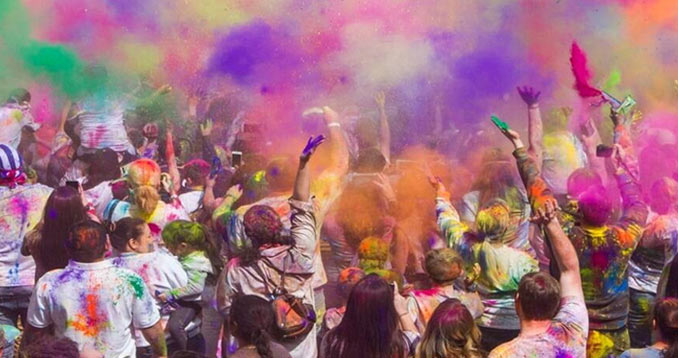

As COVID -19 cases drop in Asia, spring celebrations of Holi India on March 19th and Nowrooz, celebrating the Persian new year on March 20 and 21st will resume this year post pandemic.
Holi is also known in some states as Doljatra, or Dola Purnima. In Nepal, it is known as Fagu Purnima. It is also a public holiday called Phagwah in the South American countries of Guyana and Suriname. The day before Holi is known as Holi Dahan and can be a holiday in some states.
Holi was originally a festival to celebrate the start of Spring, good harvests and fertility of the land. The first mentions of it date back to a poem from the 4th century.
Holi was described in a 7th century Sanskrit play called “Ratnavali,” written by the Indian emperor Harsha. “Witness the beauty of the great cupid festival which excites curiosity as the townsfolk are dancing at the touch of brownish water thrown … Everything is coloured yellowish red and rendered dusty by the heaps of scented powder blown all over,” wrote Harsha.
Today it is better known as a symbolic commemoration of a legend from Hindu scripture.The story is that there was once a king who resented his son, Prince Prahlada, worshipping Lord Vishnu. He tries to murder the prince on several occasions but fails each time.
Finally, the king’s sister Holika who is said to be immune to burning sits with the boy inside a fire. However, the prince emerges unhurt, while his aunt burns in the fire and dies.
Holi Dahan remembers this event, and huge bonfires are burnt on the eve of Holi as a symbolic representation of Holika’s cremation.
The festival is also associated with the eternal love of Krishna and Radha, and hence, Holi is spread over 16 days in Vrindavan as well as Mathura – the two cities with which Lord Krishna shared a deep affiliation.
Holi is marked by colourful parades accompanied by folk songs, dances and a general sense of relaxed fun.
Nowadays Holi is an excuse for young Indians to shed their inhibitions and caste differences for a day of fun. Teenagers spend the day flirting and misbehaving in the streets, and everyone chases everyone else around, throwing brightly coloured powder and water over each other.
The tradition of throwing brightly coloured powder and water is said to come from the love story between two Hindu gods, Radha and Krishna. Krishna is famously depicted as having bright blue skin and the legend has it that he was sad he didn’t have a fair complexion like Radha. He told his mother about this and she suggested that instead of wishing for fair skin, he should instead smear Radha with paint, so they both have coloured skin; hence the tradition of trying to ‘colour’ others as a sign of affection at Holi.
The colours of the powders have symbolic meanings. Blue represents Krishna, Red represents love and fertility, green symbolises spring and new growth and yellow is the colour of turmeric, a spice native to India and a natural remedy.
The festival begins on the night of the full moon. Fires are lit on street corners to cleanse the air of evil spirits and bad vibes, and to symbolize the destruction of the wicked Holika, after whom the festival was named.The following morning, the streets fill with people running, shouting, giggling and splashing. The evenings are spent visiting friends and family.
The word Nowruz (Novruz, Navruz, Nooruz, Nevruz, Nauryz), means new day; its spelling and pronunciation may vary by country.
“A the world comes together to defeat COVID-19, Nowruz serves as an inspiration to recover and rebuild in a more just and durable way, in harmony with nature” says UN Secretary-General António Guterres message for 2021
It is celebrated as the beginning of the new year by more than 300 million people all around the world and has been celebrated for over 3,000 years in the Balkans, the Black Sea Basin, the Caucasus, Central Asia, the Middle East and other regions.
Inscribed in 2009 on the Representative List of the Intangible Cultural Heritage of Humanity as a cultural tradition observed by numerous peoples, Nowruz is an ancestral festivity marking the first day of spring and the renewal of nature. It promotes values of peace and solidarity between generations and within families as well as reconciliation and neighbourliness, thus contributing to cultural diversity and friendship among peoples and different communities.
Nowruz plays a significant role in strengthening the ties among peoples based on mutual respect and the ideals of peace and good neighbourliness. Its traditions and rituals reflect the cultural and ancient customs of the civilizations of the East and West, which influenced those civilizations through the interchange of human values.
Celebrating Nowruz means the affirmation of life in harmony with nature, awareness of the inseparable link between constructive labour and natural cycles of renewal and a solicitous and respectful attitude towards natural sources of life.
International Nowruz Day was proclaimed by the United Nations General Assembly, in its resolution A/RES/64/253 of 2010, at the initiative of several countries that share this holiday. Under the agenda item of “culture of peace”, the member states of Afghanistan, Azerbaijan, Albania, the Former Yugoslav Republic of Macedonia, Iran (Islamic Republic of), India, Kazakhstan, Kyrgyzstan, Tajikistan, Turkey and Turkmenistan prepared and introduced a draft resolution (A/64/L.30) entitled “International Day of Nowruz” to the ongoing 64th session of the General Assembly of the United Nations for its consideration and adoption.
In the 71st plenary meeting on 23 February 2010, The General Assembly welcomed the inclusion of Nowruz in the Representative List of the Intangible Cultural Heritage of Humanity by the United Nations Educational, Scientific and Cultural Organization on 30 September 2009.
It also recognized 21 March as the International Day of Nowruz, and invited interested Member States, the United Nations, in particular its relevant specialized agencies, funds and programmes, and mainly the United Nations Educational, Scientific and Cultural Organization, and interested international and regional organizations, as well as non-governmental organizations, to participate in events organized by States where Nowruz is celebrated.

Leave a Reply